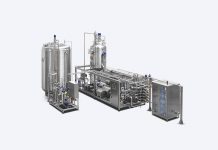EDF’s former fossil-fuelled power station at West Burton in Nottinghamshire is to host a pilot plant for nuclear fusion.
The government is providing £220 million for the first phase of STEP, the nation’s Spherical Tokamak for Energy Production project. That sum primes an investment pump, spurring the UK Atomic Energy Authority to produce a concept design for a fusion reactor by 2024.
Fusion mimics physical reactions powering the sun and stars. It is the process by which two light atomic nuclei combine, releasing vast quantities of energy. Supporters see it as offering major potential to deliver safe, sustainable, low carbon energy for future generations.
West Burton was one of 15 sites which in early 2021 bid to host the UK AEA’s STEP project. The Notts facility was chosen from a short list of five, after a process of of detailed technical and socio-economic assessment.
The site houses A and B generators. After 56 years of burning coal to make power at the A plant, EDF had been due to cease all output last month, but has extended the deadline until next March, due to power shortages caused by Putin’s war in Ukraine.
EDF sold its 1.3 GW combined cycle gas-fired B plant to EIG in April 2021, a mere eight years after it began producing electricity.
Nottinghamshire’s County Council had backed West Burton with its Fossil2Fusion campaign, supported by the Midlands Engine partnership and the Energy Research Accelerator, an alliance of industry bodies and scientists.
Energy Research Accelerator director Professor Martin Freer, said: “We welcome (the) announcement of West Burton as home for the UK’s first STEP plant. The site is part of ‘Megawatt Valley’ and has been crucial to the UK’s power generation industry for decades.”
“Fusion has the potential to be transformative for the way we produce energy here in the UK. It could provide an almost limitless supply of safe, clean electricity and help with the toughest decarbonisation challenges by using heat to manufacture hydrogen and synthetic clean fuels – other areas where our region and ERA have expertise.
For Midlands Engine, its chair Sir John Peace enthused:
“The Midlands Engine partnership welcomes the government and UKAEA’s decision to choose West Burton as the site for its STEP fusion prototype.
“In an area which has long suffered from underinvestment, the site stands to play a crucial role in boosting local and regional economic activity, job creation and productivity.
”The project is more than a power station. It will require an ecosystem of innovation and development and will become a global focus for fusion power. This is an unrivalled opportunity to support our levelling-up agenda, by generating high quality jobs, building a first-class supply chain and further strengthening our regional skills base”.





Fusion has had potential for the last 60 years.
It would be much cheaper to use the sun’s fusion energy in the Sahara Desert using DESERTEC. This already has a working prototype, and is costed at no more than 5p a unit. Fusion power on the other hand has huge problems still. The taurus design has no way of removing the heat once a reaction starts, so that will need a complete redesign. Also, the taurus design suffers neutron damage to the torus metalwork from the plasma, rendering it radioactive and brittle. There is no known solution to this problem.
Pouring more money into a scheme that does not even have a working prototype that can run for more than a few seconds after 60 years of trying, and contains a flaw that has no known solution, has to show questionable judgement. I would not bet 10p on a scheme like this succeeding.